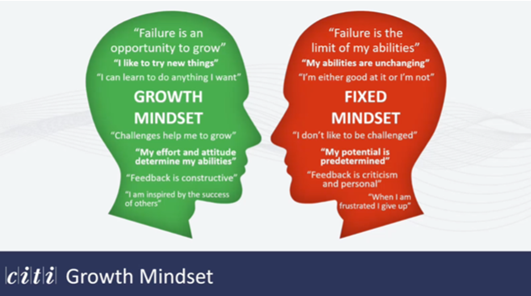4 tips to developing a growth mindset
Your mindset has the ability to determine every aspect of your life. From the way your day will unfold, to your productivity levels, or even how successful you’ll be in an interview.
The two mindsets we are going to be covering in this article are the ‘Fixed’ mindset, and the ‘Growth’ mindset.
Fixed mindset
A ’Fixed’ mindset involves an individual believing that their traits are fixed and cannot be developed.
An example of this may be “I’ve never been good with technology”. Here, the individual believes their technological ability is permanent and cannot evolve. They typically have a belief of “There’s nothing I can do to change that, so therefore, it is outside of my realm of control and I’m not going to engage in that process”. For example, let’s say a company is making technological upgrades. This ‘no good with technology’ mindset may kick in and prevent those with a fixed mindset from embracing the change, instead, seeing it as an obstacle that can’t be overcome.
Change is problematic with people occupying a fixed mindset. This is because it brings about new challenges which force them outside of their comfort zone. This makes them feel as though they are bound to fail, as it’s not within their fixed traits to succeed in this new environment. If people in this mindset don’t believe they are inherently good at something, they’re less likely to entertain it. This self-doubt paints the concept of change in a negative light and makes them fear the change, becoming more resistant.
Growth mindset
A ’Growth’ mindset focuses more so on enabling an individual to adapt to challenges and changes in their environment. These people view these as an opportunity, instead of a threat. Change can be seen as a positive as people with this mindset are more likely to see how this can be beneficial to them.
For example, the development or improvement of skills: as opposed to a fixed mindset, growth mindset thinking believes that someone’s efforts and attitudes dictate their abilities and that they’re able to accomplish anything they put their mind to. So, going back to the previous example of a company making technological changes. Rather than having a thought process of “I’m not great with technology, there’s no point in me even trying”, it switches into “I’ve never been great with technology, but this gives me the opportunity to learn to be.”
Determining the mindset someone currently resides in can be hugely beneficial to both themselves and their company. Understanding the ways in which they can move from one mindset to the other can help to encourage change to be viewed as a positive opportunity to grow as an individual, rather than a burden. Being in a ‘Growth’ mindset will allow them to prosper from instances of change and embrace it in the meantime.
4 tips to developing a Growth mindset
Whilst there are countless ways you are able to develop a Growth mindset – Here are 4 that we recommend helping to start the process:
- Pay attention to your thoughts and the way in which you speak. Negative thoughts are likely to create barriers. Believing you’re unable to do something will make this an inevitable outcome. Try to make your thoughts more positive and opportunistic in nature.
- Identify your strengths and weaknesses. By knowing what you’re good at, you know where you’re likely to excel. View your weaknesses as an opportunity to grow – understand how you can build upon these.
- Take the positives out of feedback and criticism. Regardless of how harsh it is worded, there is always something you can learn from feedback given. Having this mindset and figuring this out not only has a more positive impact mentally, but also allows you to understand how you can improve in the future.
- Be patient with yourself. This change in mindset isn’t something that will happen overnight. A growth mindset develops from the creation of habits and routine. It takes on average two months to develop a new habit, so you won’t see results straight away. Don’t let this discourage you!
If you’re interested in knowing more about this, please feel free to check out the webinar we hosted with HPCA recently on Making Change Wanted.

You may also be interested in...
About Us
Suite 26 - Shenley Pavilions
Chalkdell Drive
Milton Keynes
Buckinghamshire
MK5 6LB


